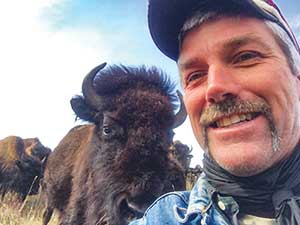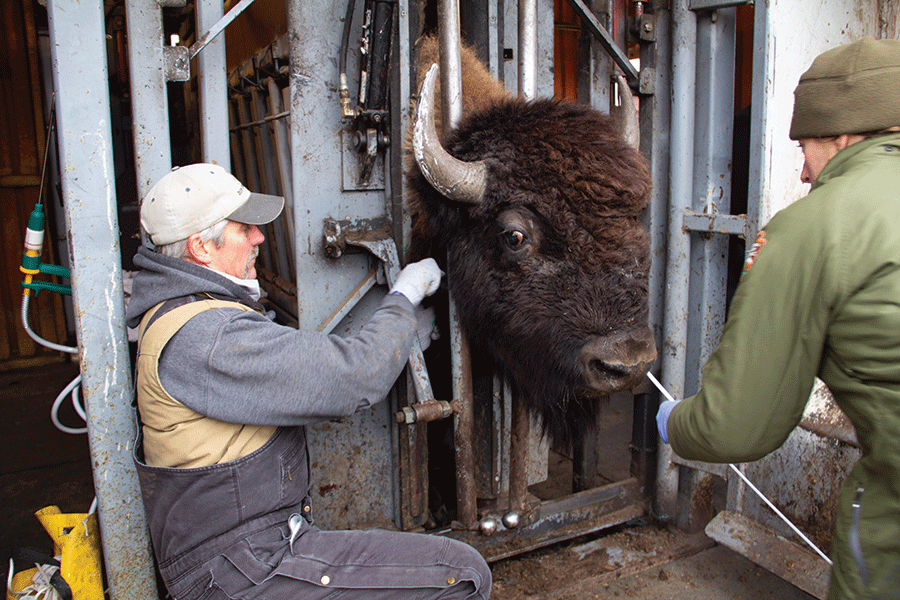At Home on the Range
Dr. Tom Bragg’s career focuses on care and management of bison herds.
Story by Joe Montgomery
Photo caption top: Dr. Tom Bragg, DVM class of 1993, follows a herd of bison at Snowcrest Ranch in Montana. Photo by Aaron Paulson. Photo caption below: Dr. Bragg takes a selfie with one of the bison he calls 'Carla.'
 A swale is an impression that is formed in the ground by the constant movement of bison across a preferred path.
A swale is an impression that is formed in the ground by the constant movement of bison across a preferred path.
For Dr. Tom Bragg, there was not exactly a swale nor a preferred path, but instead, there was an unexpected journey that led him to work with bison.
“When I went to veterinary school, my main interest was horses,” Dr. Bragg recalls. “My grandfather was in the cavalry, and he taught me to ride and to appreciate horses. My father was a biologist — a prairie ecologist — and both my parents had gone to K-State. I wanted to follow a ranching-related career. I started undergraduate school in animal science, and, while I was in animal science, I started meeting more and more pre-vet and vet students.”
After spending time with several veterinary students, Dr. Bragg says he became more interested in veterinary school. Being from Omaha, Dr. Bragg was able to take advantage of the reciprocity program that K-State had with the state of Nebraska. This program allowed a certain number of students to study in the veterinary college under the instate tuition cost, while giving Kansas students similar access to medical school at the University of Nebraska-Lincoln.
If you build it, you will learn
Dr. Bragg says that one of his side hustles during his time in veterinary school turned out to be an omen of what lied ahead. During his summers at college, he worked jobs building bison fence in Nebraska and later for Kansas State University at Konza Prairie near Manhattan.
“As I went through veterinary school, I found a passion for agriculture and working with the ranchers and beef production,” Dr. Bragg says. “I had a growing desire to be outside working on these properties and with their animals.”
After graduating with his DVM degree in 1993, Dr. Bragg went to a mixed animal practice in Wessington Springs, South Dakota, where he practiced for six years with a short stint in Nebraska.
“We were the only veterinary clinic in town,” he says. “But, during that one year I was in Nebraska, I met a rancher who had some bison, and he asked me if I would work on them. I said, ‘Sure, I’ve been around bison before.’ And so, I helped him out. He got me started thinking about it [changing career focus].”
In September of 1999, Dr. Bragg found a position with the Nature Conservancy in Colorado, where he managed a 103,000-acre bison and cattle operation in the San Luis Valley.
“I took that job in southern Colorado and just fell in love with it,” Dr. Bragg says. “I didn’t grow up on ranches, so there really wasn’t an easy path for me to move into a family ranching operation. I wanted to be more involved that way and get to know a property and a herd really well. And I found a passion for that. So, in 1999, I left the practice and started managing bison herds. I never looked back, and now I’ve been working with bison for 25 years!”
Dr. Bragg said family was another factor in his decision.
“Our family was really growing,” Dr. Bragg says. “We just had our first child a couple of years before, and we were expecting more. We ended up having three kids. I wanted to have a more flexible schedule and be able to spend more time with them. The veterinary practice had been really busy, and we were gone a lot, especially during calving season. Even though it was busy, I am so thankful for the time I had in that practice and for what it taught me and for the opportunities it has made available to me.”
Dr. Bragg treats a bison with Dr. Danielle Buttke, a veterinary epidemiologist an the One Health coordinator for the National Park Service. Photo by Beth Bragg
Learning more about bison
“When I started working with bison, I didn’t really think there would be that much veterinary work other than some regulatory work for animal sales,” Dr. Bragg says. “And for several years that was true. But as time went on, we began to see more disease and health issues with bison.”
Dr. Bragg says there wasn’t much information on bison and that he had to develop relationships with other producers and researchers at universities and veterinary diagnostic labs to start figuring out what was going on.
“The bison universe is a small one and you get to know those people really quick,” Dr. Bragg says.
An opportunity came up for Dr. Bragg to join a new organization.
“When I moved to Turner Enterprises, there was already another person who worked as the organization’s veterinarian,” Dr. Bragg says. “I was managing a property, but I would help him out a lot. He lived in Montana, and I lived in Nebraska.”
Dr. Bragg says most of the Turner bison are in Nebraska and South Dakota. The staff veterinarian taught him a lot about bison and the common bison health issues, but then that veterinarian retired.
“About six years ago, he started transitioning into retirement,” Dr. Bragg says. “About four years ago, he retired completely, and I took over that position full time. It came at a good time with all of our children having started their own lives and that’s when I moved to Rapid City [South Dakota].
Now that my full-time job is the veterinarian, I don’t manage a property anymore, but I have an incredible opportunity to travel to the other properties frequently.”
Dr. Bragg says it has been an interesting journey.
“I really enjoyed bison and working around them,” Dr. Bragg says. “It’s funny, the things I never would have thought I’d have been involved in 25 years ago when I stepped away from general practice, but here I am.”
Research and teaching
Dr. Bragg embraces the mission of the Turner Institute of Ecoagriculture, which is “To research, practice, and disseminate sustainable strategies and techniques for conserving ecosystems, agriculture and rural communities.”
“While working under the Turner Institute of Ecoagriculture, we cooperate with researchers at South Dakota State University (SDSU) and other universities as well as state and federal agencies to perform studies on many of our properties,” Dr. Bragg says. “Our work focuses on bison health, behavior, grazing management and bison production practices as well as a wide array of wildlife and ecosystem functions.”
Dr. Bragg is currently collaborating on research studies on Mycoplasma bovis in bison.
“I have been helping collect samples including deep nasal swabs and blood for use in these studies on two different properties,” Dr. Bragg says. “We are involved in a lot of research with multiple partners, and we make that research available to other bison producers as well as those involved in bison conservation and wildlife management. It is really a team effort.”
The bison work takes Dr. Bragg to several locations. Turner has ranches in Montana, South Dakota, Nebraska, Kansas and New Mexico, which includes about 45,000 bison on 13 different ranches in five different states.
“I have a veterinarians’ license in each of those states that I have to maintain,” Dr. Bragg says. “Much of the time during the year, I’m in South Dakota, but there are a lot of times where I’m traveling to one of the ranches, mostly while they are handling their bison or if there are specific health concerns.”
Dr. Bragg has an adjunct faculty appointment with SDSU, where he spends part of his time providing outreach.
“I often travel and give presentations to various groups regarding bison health and management as well as discussing the research projects we are conducting on our properties,” Dr. Bragg says.
The groups range from veterinarians, researchers and bison producers to veterinary students and animal-science students at SDSU’s new class in bison studies.
“Turner’s interest in bison includes a blend of conservation and ranching for production,” Dr. Bragg says. “Along with promoting ecosystem health, we have to survive financially, so there are a lot of bison that go into production. As you can imagine, with the annual reproduction from 45,000 bison, we have about 10,000 bison that we need to move off of our properties every year to protect our forage resources. These animals are used in both grain-fed and grass-fed meat sales.”
Dr. Bragg says that some Turner bison herds are also kept for their unique genetics.
“We’re looking at trying to conserve the genetics in those herds,” Dr. Bragg says. “And management is what we’re focusing on, from maintaining genetic diversity to addressing health issues and disease concerns.”
Dr. Bragg did not envision his carer would involve bison management, but as a K-State-educated veterinarian, he was well-prepared to follow this path. Photo by Beth Bragg
Making connections with students
Dr. Bragg says he started an externship program two and a half years ago.
“There was a student out of Colorado State University who happened to know somebody in our company and wanted to see if there was an opportunity for an externship,” Dr. Bragg says. “For years I’ve been trying to set up an externship program and to have veterinary students come out, but then you just get busy — and you don’t get it all set up. Well, this student at CSU helped me get it going.”
In February 2025, Dr. Bragg hosted Mikayla Lacher, a fourth-year K-State veterinary student.
“She reached out through the National Bison Association, so I called her back,” Dr. Bragg says. ”Students usually want to come do an externship in the summer because it’s convenient, but the summer is really slow for us. Most of our bison work happens between October and the end of February. Right now, it’s just a one-week externship, but we will work bison every day.”
Dr. Bragg says the students participate in ultrasound procedures for pregnancy checks and learn to manually palpate the bison too.
“In addition to pregnancy diagnosis, we do vaccinations, and we’ll perform necropsies if there are any available,” Dr. Bragg says. “We bleed 20 head and send samples into the lab for routine titer checks on our herds to see if they’ve been exposed to any of the pathogens we’re looking at. And we always talk about how we manage the herd.”
Dr. Bragg says a huge part of managing bison is how a person handles the bison.
“I try to give the student some time learning from the people who have taken low-stress livestock handling classes,” Dr. Bragg says. “It’s probably one of the least emphasized subjects but has the biggest impact on managing bison.”
The path less traveled
Dr. Bragg says he believes a veterinary education is extraordinary for the opportunities it creates.
“I’m thankful for the things that it’s afforded me to be able to do — it’s the reason I’ve gotten this far, especially in this position,” Dr. Bragg says. “It’s not the typical path that a lot of veterinary students go to veterinary school for, but it’s really pointed out to me that if you really enjoy something — if you just hang around it long enough — it seems like the positions start to show up.”